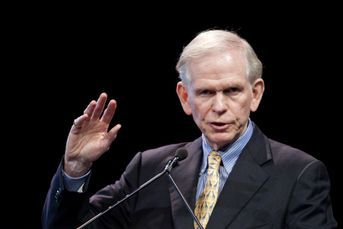Investors looking to protect capital as debt ceiling looms
No panic as many see last-minute deal getting done.
With the deadline for avoiding a U.S. default looming, investors from Boston to Bangalore are moving to cash, extending the maturities of their short-term Treasury holdings and buying options to help protect themselves should stock and bond prices tumble.
Some JPMorgan Chase & Co. private-bank clients are raising cash, while others are dumping Treasury bills with maturities beyond the Oct. 17 debt ceiling deadline for longer-dated bonds. Stewart Capital Advisors LLC favors insurance companies, technology stocks and health care providers, which now have lower valuations. Money is flowing out of an exchange-traded fund that tracks American banks and into overseas equities.
While most investors say a default will be averted, the potential for calamity should political leaders fail to renew U.S. borrowing authority before it runs out is moving some to take measures to safeguard their assets. A Treasury Department report Oct. 3 said consequences would be “catastrophic” should the U.S. fail to make payments, including higher interest rates, lower investment and slow growth for decades to come.
“We want to protect capital first,” said Kevin Kearns, a fixed-income portfolio manager at Loomis Sayles & Co. LP, which manages $188 billion. While Loomis is forecasting that a default will be avoided, the back-and-forth negotiations may provoke some investors to sell assets. “We have our shopping list ready if things go on sale,” Mr. Kearns said.
Mr. Kearns oversees $1.4 billion in a strategy known as long-short, where an investor can speculate on a security’s price either rising or falling.
Investors withdrew $4 billion from ETFs that track U.S equities between Oct. 3 and 8, data compiled by Bloomberg on fund flows show. At the same time, they added $418 million to the iShares MSCI EAFE ETF, which buys European, Australian and Israeli shares, the most for any ETF tracked by Bloomberg. The Vanguard FTSE Europe fund got $385 million, putting it in second place.
Last week, investors withdrew $780 million from the Financial Select Sector SPDR Fund tracking financial companies in the S&P 500, the most since April 2010, according to data compiled by Bloomberg.
Options on the Chicago Board Options Exchange Volatility Index, used to hedge against stock swings, saw record volume of 1.78 million contracts Oct. 8. Traders that day bought almost double the number of calls to buy, compared with puts to sell, data compiled by Bloomberg show. Owning bullish options on the Vix can offset losses when stocks drop, because they become more valuable as price swings widen.
Last-minute
Most investors have yet to become concerned that the debt ceiling will be breached, citing the last-minute resolution of the August 2011 showdown as a model that shows a deal will be achieved in time.
“None of my investors have so far called me to say, ‘I want out,’ or ask, ‘Is this really a crisis situation?’” Jim Paulsen, the chief investment strategist at Wells Capital Management, which oversees about $340 billion, said in a telephone interview. “The American psyche is in much better position today. They don’t look at every issue as Armageddon. It’s just another problem. They are not rushing to gold or U.S. Treasuries or to the dollar.”
About 41% of investors in a TD Ameritrade Holding Corp. survey said they haven’t made changes to their investments as a result of the government shutdown that began Oct. 1 or a possible default. Twelve percent said they’re “taking advantage of opportunities,” and 10% said they’ve moved into cash in the immediate term, according to the poll of 693 consumers conducted Oct. 3.
Concern that a default might happen is starting to show up in the market for short-term obligations of the U.S. Treasury.
Treasury bill rates rose after President Barack Obama rejected calls Oct. 8 to invoke the Constitution’s 14th Amendment to skirt congressional approval for issuing new debt.
Rates on Treasury bills due Oct. 17 fell 0.03 percentage points to 0.456% at 10:22 a.m. London time, after jumping 0.2 percentage points Oct. 9. The yield was negative as recently as Sept. 26. The rate on bills maturing Nov. 14 rose as high as 0.275% Oct. 9, compared with 0.02% on Sept. 30. Rates on bills due Nov. 21 were at 0.05%, down from 0.065% reached Oct. 4, the highest since July 3.
Some investors have been “rolling out those Treasury bills to future maturities” in December and into 2014, Megan McClellan, head of U.S. fixed income at JPMorgan Private Bank, said in a Bloomberg Television interview Oct. 9. “For people that are nervous, rolling forward is OK, and also going to cash. We have seen, as we saw in 2011, some percentage going to deposits.”
Money market mutual funds can cope with a short-term default in U.S. Treasuries as long as it doesn’t trigger the kind of investor run that followed the collapse of Lehman Brothers Holdings Inc. in 2008, according to Fitch Ratings Ltd.
The funds have high levels of short-term liquidity and have reduced their holdings of Treasuries that would be most immediately affected by the failure of the U.S. to extend its borrowing capacity, the ratings company said Oct. 9 in a report.
“We have avoided maturities in the time period toward the end of October,” Nancy Prior, head of money funds at Fidelity Investments, said in an interview. Fidelity is the largest manager of U.S. money funds, with $427 billion in assets as of Aug. 31, according to Crane Data LLC.
Bill Gross buying
As Fidelity has sought to avoid Treasury bills maturing near the deadline, Pacific Investment Management Co. LLC has been buying them as their yields have risen, said co-chief investment officer Bill Gross, manager of the world’s largest bond fund at Pimco.
“Their selling begets opportunistic buying on the part of Pimco,” Mr. Gross said in an interview on Bloomberg Television. “We’re picking up pennies on the street. This is a particular penny that we think is risk-free.”
For Mark Luschini, chief investment strategist for Janney Montgomery Scott LLC, the dip in stock prices may become a chance to increase his ownership of U.S. equities.
“Where we are holding significant cash, we have been nibbling,” Mr. Luschini wrote in an e-mailed response to questions. He added to his equity positions as the S&P 500 fell to 1,660, and “we will buy more aggressively if we near 1,600, all things being equal.”
Investors who are concerned about a default should use an options strategy known as a collar on their largest or most volatile equity holdings, according to Randy Frederick, managing director of active trading and derivatives at The Charles Schwab Corp. To implement the trade, investors buy a put, or option to sell, with an exercise price below the current stock level, financed by selling call options with a higher strike price.
Randall Warren, chief investment officer of Warren Financial Service, purchased options on the Vix as protection against surging stock volatility if the U.S. defaults on its debt.
Mr. Warren said he bought calls that become profitable if the Vix rises 12% to 22 by Oct. 16, the day before U.S. borrowing authority lapses. He also purchased calls with a 32 strike price for October to protect against bigger swings in the equity market, as well as 22 and 32 contracts that expire in November as a hedge if the talks are extended.
“Buying these options very, very cheaply and getting the explosive upside if something serious does occur with the markets, then that is a way to hedge your bets without a whole lot of money,” Mr. Warren, who oversees about $100 million, said in a phone interview.
‘Worst case’
The S&P 500 has fallen 1.5% since the U.S. government shut down, and the Vix has jumped 18% to 19.6. That compares with a level of 48 when S&P cut the U.S. debt rating in August 2011, the highest since before the bull market started in 2009.
Supreeth S.M., chief executive at Quant First Asset Advisors India Ltd., bought put options on the nation’s CNX Nifty Index stock gauge with an exercise price 10% below the index level to protect against the “worst-case scenario” of a U.S. default. He’s funding the trade by selling call options on the measure.
“A U.S. default is highly unlikely, as we expect lawmakers to come around to avert a disaster,” Supreeth, whose firm manages about $100 million in options, said in a phone interview on Oct. 8. “However, something bad may happen, and we are advising clients to hedge.”
(Bloomberg)
Learn more about reprints and licensing for this article.








